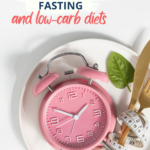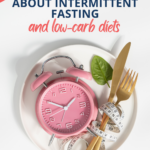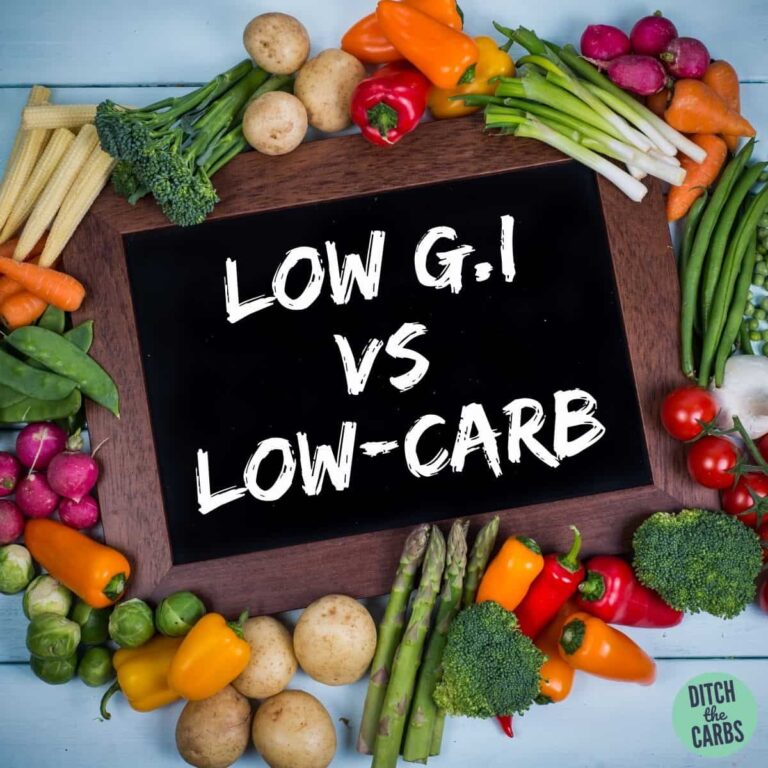If you’re over 40 and trying to lose weight, you know that it can be a tough battle. But what if we told you that there’s a way to help give your weight-loss efforts a boost?
Intermittent fasting combined with a low-carb diet can help you lose weight safely and effectively. And it’s super easy too!
But what is intermittent fasting? What are the benefits of intermittent fasting? And how can you use intermittent fasting with a low-carb, ketogenic diet to lose weight effectively and safely? This article will answer all those questions and more.

What Is Intermittent Fasting?
Intermittent fasting is simply periods of time where you don’t eat, followed by periods of time where you do eat. That’s it!
Are you ready to lose weight and heal your body for life (without dieting, drugs, or making yourself miserable)?

Our free on-demand video training will walk you through how to make this THE year you set health goals…and keep them.
Ok, there is a bit more to it because there are different lengths of time you can fast. Check out the different types of intermittent fasting and pick the one that matches your lifestyle the best.
16/8 Protocol
There are many different types of intermittent fasting protocols, but the most popular one is the 16/8 protocol. This means that you don’t eat for 16 hours out of the day, and then you have an 8-hour window in which to eat all your meals.
For example, you could stop eating at 8 in the evening and then not eat again until noon the next day. That would be a 16-hour fast. Then you would have an 8-hour window to eat from noon until 8 p.m.
This is the most popular intermittent fasting protocol because it’s the easiest one to stick to. It’s basically just cutting out breakfast and late-night snacks.
5:2 Diet
Another popular intermittent fasting protocol is the 5:2 diet. This means that you eat normally for 5 days out of the week, and then for 2 days out of the week, you eat very little.
For example, on Monday, Wednesday, Friday, Saturday and Sunday, you would eat normally. Then on Tuesday and Thursday, you would eat very little or nothing at all.
This type of intermittent fasting can be a bit more difficult to stick to because you have to be very disciplined on the 2 days that you’re fasting. But many people find that it’s worth it because of the benefits they experience.
If you are doing the Thin Adapted System ™(TAS), you could do protein fasts on the 2 days you fast, but we don’t count calories. This protocol doesn’t fit in very easily with TAS because we focus more on macros and not so much on calories.
The Warrior Diet
The Warrior Diet is a type of intermittent fasting that’s a bit different from the other two mentioned above. With the Warrior Diet, you eat one large meal at night and then fast during the day.
Basically, it’s like a 20/4 fast. You fast for 20 hours and then eat all your macros for that day within a four-hour window.
This type of intermittent fasting can be difficult to stick to because you’re going for such a long period of time without food. But some people find that the benefits are worth it.
Alternate-Day Fasting
Alternate-day fasting is exactly what it sounds like. You fast every other day. So, for example, you would fast on Monday and then eat normally on Tuesday. Then you would fast on Wednesday and eat normally on Thursday, and so on.
This type of intermittent fasting is also tough to stick to because you’re going an entire day without food. But, like the other types of intermittent fasting, many people find that the benefits are worth it.
You basically have to try them out and pick the ones that you can stick to. If you find that you don’t have energy and you feel extremely hungry while you fast, don’t do it. TAS is all about fueling your body and not going without. You shouldn’t feel worn down and starving.

What Are The Benefits Of Intermittent Fasting?
There are many benefits of intermittent fasting, both physical and mental, which is why so many people choose to do it. Let’s look a bit closer at all the benefits of intermittent fasting.
Weight Loss
One of the most common reasons people start intermittent fasting is for weight loss. And there’s a good reason for that! Intermittent fasting has been shown to boost weight-loss efforts by increasing metabolism and reducing calorie intake.
A review of studies in 2020 showed that participants who followed an intermittent fasting protocol lost more weight, more fat, and more inches around their waist than those who didn’t intermittent fast.
If your biggest goal is to lose weight, intermittent fasting could be a great option!
Increased Energy Levels
Intermittent fasting can also help to increase your energy levels. When you’re not eating for long periods of time, your body has to find other ways to fuel itself. And one way it does that is by breaking down stored sugar and fat for energy.
This process of breaking down stored sugar and fat for energy is called becoming Thin Adapted. And many people find that they have more energy when their bodies are Thin Adapted.
Studies prove that this is true. In fact, a 2018 study showed that participants who followed an intermittent fasting protocol had increased energy levels and felt less tired than those who didn’t intermittent fast.
Improved Brain Function
Intermittent fasting has also been shown to improve brain function.
Your memory, recall and ability to solve or handle stressful situations could improve by adding some intermittent fasting to your daily habits.
In fact, a 2016 study showed that participants who followed an intermittent fasting protocol had improved memory and cognitive function than those who didn’t intermittent fast.
Who knew that this could help your memory too?!
Reduced Inflammation
Intermittent fasting has also been shown to reduce inflammation.
Inflammation in the body is linked to a whole host of diseases and health conditions, like arthritis, gastrointestinal issues and even depression. So reducing inflammation is always a good thing!
Science proved this is true in a 2015 study when participants who followed an intermittent fasting protocol had reduced levels of inflammation than those who didn’t intermittent fast.
As you can see, there are many benefits of intermittent fasting. And this is just a small sampling of all the benefits that have been studied so far.
Intermittent fasting does so much more for your body than just help it become Thin Adapted and lose weight (even though that’s one of the biggest benefits of all).
Annie’s experience with intermittent fasting:
I started intermittent fasting about 2 months ago and I’m loving it! I’ve been doing the 16/8 protocol, which means that I fast for 16 hours and eat for 8 hours.
I typically start my fast at 8 p.m., which means that I don’t eat again until noon the next day. This was a bit of an adjustment at first, but I quickly got used to it.
I find that I have more energy and focus during my fast, and I’m also losing weight! I’ve already lost 7 pounds in 3 weeks after combining intermittent fasting with the 28 Day Metabolism Reset, and I’m feeling great!
Risks Of Intermittent Fasting With A Low-Carb Diet
There are a few things to be aware of when using intermittent fasting with a low-carb diet.
Type 2 Diabetes or Insulin Resistance
First of all, if you are insulin resistant or have Type 2 diabetes, it’s important to check with your doctor before starting any kind of dietary change or new exercise regimen. This is because fasting can cause your blood sugar levels to drop too low, which can be dangerous.
That being said, if you are insulin resistant or have Type 2 diabetes and you want to try intermittent fasting, there are a few things you can do to help make it safer.
Eat Low-Carb, High-Fat
First of all, make sure to eat a high-fat, low-carbohydrate diet. This will help to keep your blood sugar levels stable.
Monitor Blood Sugar
It’s important to monitor your blood sugar levels closely. Make sure to have a snack or meal containing carbohydrates (like fruit, honey, or maple syrup) if your blood sugar levels start to drop too low.
If you are insulin resistant or have Type 2 diabetes and you want to try intermittent fasting, make sure to check with your doctor first and then follow the tips above to help make it safer.
Go Slowly
Secondly, when you are first starting out with intermittent fasting, it’s important to go slowly and listen to your body. We recommend starting with a 12-hour fast once or twice per week (for example, not eating from 7 p.m. until 7 a.m. the next day).
Once you’re comfortable with that, you can start increasing the length of your fasts until you’re up to 16 hours or more. This is because it can take a while for your body to adjust to not eating for long periods of time, and you don’t want to overwhelm it.
Drink Water And Electrolytes
Finally, make sure you’re drinking plenty of water and electrolytes (salt) when doing intermittent fasting and low carb. This will help prevent any headaches or dizziness that can sometimes occur when first starting out.
Electrolytes are important to your health because they help to keep your body hydrated, and they help nutrients move into your cells.
Yup, you’ll actually get more nutrients from the food you eat if you stay hydrated with plenty of electrolytes.
Combining Intermittent Fasting With A Low-Carb Diet – Questions Answered
Combining intermittent fasting with a low-carb diet can help you break a weight-loss plateau or jump-start your efforts and help you become Thin Adapted quicker.
Here are some questions people have about combining intermittent fasting with a low-carb lifestyle.
How do you do intermittent fasting with a low-carb diet? Is it safe?
Yes, it is safe to do intermittent fasting while eating low carb. In fact, this can be a really easy way to control yourself from indulging in late-night snacks that might make you overeat carbs.
How many days in a row can you do intermittent fasting while eating low carb?
There is no set number of days, but most people find it easiest to do 2-3 days per week. This way, you can still have some days where you’re not fasting, which can help your body adjust.
What are the best times to eat while intermittent fasting on a low-carb diet?
The best times to eat while intermittent fasting on a low-carb diet are:
- First thing in the morning, as soon as you wake up
- Before your workout
- Post-workout
- In the evening, before bed
What should you eat while intermittent fasting on a low-carb diet?
The best things to eat while intermittent fasting on a low-carb diet are:
- High-protein foods like meat, fish, and eggs
- Healthy fats like avocados, olive oil, and coconut oil
- Low-carb vegetables like broccoli, spinach, and kale
- Water and electrolytes
We have all sorts of recipes that fit in perfectly with intermittent fasting and a low-carb lifestyle. Check out the Thinlicious™ recipe index for some yummy ideas!
If you are doing intermittent fasting with a low-carb diet, make sure to listen to your body and go slowly at first. Drink plenty of water and eat high-protein foods to help keep you feeling full.
You’ve Got This!
When combined with a low-carb, ketogenic diet, the benefits of intermittent fasting are even greater. In fact, combining these two together is an incredibly effective way to lose weight quickly and safely. So what are you waiting for? Give it a try!
But don’t do it alone! We recommend starting with our Thinlicious™ 28 Day Metabolism Reset, which is designed to introduce you to the Thin Adapted System and help you retrain the way your body burns fuel in just four weeks. Get it HERE.
Pin for later:

What if you could actually take control of
your health in just 10 days?
It’s not your fault you can’t lose weight as a woman over 40 even though you’ve likely tried literally everything. Your metabolism probably feels broken and your hormones are likely all out of whack.
But you can fix it all with ONE simple change: eliminate sugar. We make it super easy with daily lessons teaching you the science behind what makes us gain weight in our midlife and beyond! Are you ready to get started now?












3 Comments